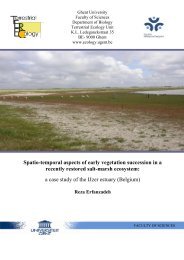PhD Arthur Decae 2010 - Ghent Ecology - Universiteit Gent
PhD Arthur Decae 2010 - Ghent Ecology - Universiteit Gent
PhD Arthur Decae 2010 - Ghent Ecology - Universiteit Gent
You also want an ePaper? Increase the reach of your titles
YUMPU automatically turns print PDFs into web optimized ePapers that Google loves.
Variation. Total sizes (BL) in the sample of 9 ♀♀ varied between 29.1mm and 17.0mm.<br />
Variation in the shape of the carapace (CL/CW = 1.1-1.2; n =9), the position of the fovea<br />
(CL/Cap = 1.4-1.5; n = 9) appeared to be very low. Differences found in the length/width<br />
ratio of the ocular quadrangle (l/w = 0.6 – 0.8; n=9) suggest some local geographical<br />
variability or cryptic diversity.<br />
Natural History. Simon (1888) reported this species to be widespread in the Tell region of<br />
Algeria and western Tunisia where its burrows were all dug in steep to vertical surfaces along<br />
roads and rivers. The burrows were reported to be shallow (6-10cm), internally lined with<br />
dense white silk and closed at the entrance by a stiff thin trapdoor.<br />
Ummidia aedificatoria (Westwood 1840) Figs. 15,19.<br />
Actinopus aedificatorius Westwood 1840:175 Pl. 10.<br />
Sphodros aedificatorius: Walckenaer, 1842: 438.<br />
Cteniza aedificatoria: Ausserer 1871: 155.<br />
Pachylomerus occidentalis Simon 1909:8 NEW SYNONYM.<br />
Pachylomerus occidentalis: Frade & Bacelar 1931:512, figs 5-6.<br />
Remark. The type of U. aedificatoria is a dried specimen in the Oxford University Museum<br />
collection, of which photographs by Ray Gabriel were seen, but diagnostic details of the<br />
sexual organs could not be studied. Westwood’s original description fortunately is very<br />
detailed and extensive and is furthermore accompanied by a good set of illustrations<br />
(Westwood 1840: Plate 10). Two characters of supposedly diagnostic value − the relatively<br />
short ocular quadrangle and the reduced rastellar process− are sufficiently clear in the dried<br />
specimen and the illustrations to synonymize Westwood’s type of U. aedificatoria with<br />
Simon’s type of U. occidentalis that originated from roughly the same type location (Tangiers<br />
province in northwestern Morocco. Fig. 24). Because Simon’s spider at the MNHN Paris is<br />
the only specimen available for closer study, the limited additional diagnostic and descriptive<br />
information given here is based on that specimen.<br />
Material studied. 2 ♀♀ on photographs in the Westwood collection, preserved in dry<br />
condition in the Oxford University Museum. 1 ♀ found in Simon’s collection at the MNHN,<br />
Paris, probable type specimen of U. occidentalis<br />
that is here synonymised with U. aedificatoria.<br />
Diagnosis. Differs from all other Mediterranean<br />
Ummidia species by the short bent central<br />
section of the spermathecae (Fig. 19), the low<br />
length/width ration of the ocular quadrangle<br />
(Fig. 15) and the reduced rastellar process.<br />
Measurements. Female: BL = 18.1; CL = 8.2;<br />
CW = 6.7; Cap = 5.8; EL = 0.4; EW = 0.8.<br />
Variation. Only three female specimens are<br />
currently known, two of which have been<br />
preserved in dried condition for almost 170<br />
years. Nevertheless it is clear that U.<br />
aedificatoria falls in the same size range as the<br />
other western Mediterranean Ummidia species.<br />
Total body lengths of adult females in the small<br />
sample range from 18.1 to 29.0mm.<br />
Natural History. Neither Westwood 1840 nor<br />
Simon 1909 provides any information about the<br />
natural conditions in which U. aedificatoria is<br />
10 11<br />
12<br />
14<br />
13<br />
15<br />
Figs. 10 -15 Eye-formations in dorsal view of western<br />
Mediterranean Ummidia species. 10. U. algarve male<br />
holotype; 11. U. algarve female paratype; 12. U. picea<br />
male; 13. U. picea female 14. U. algeriana female; 15. U.<br />
aedificatoria female.










